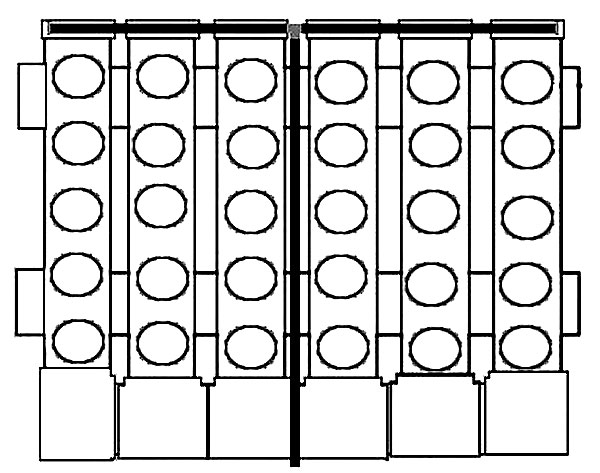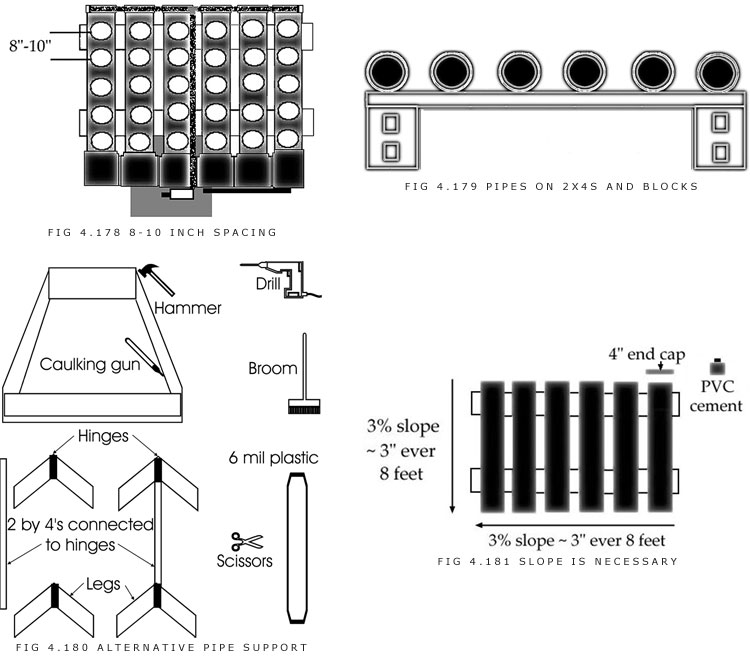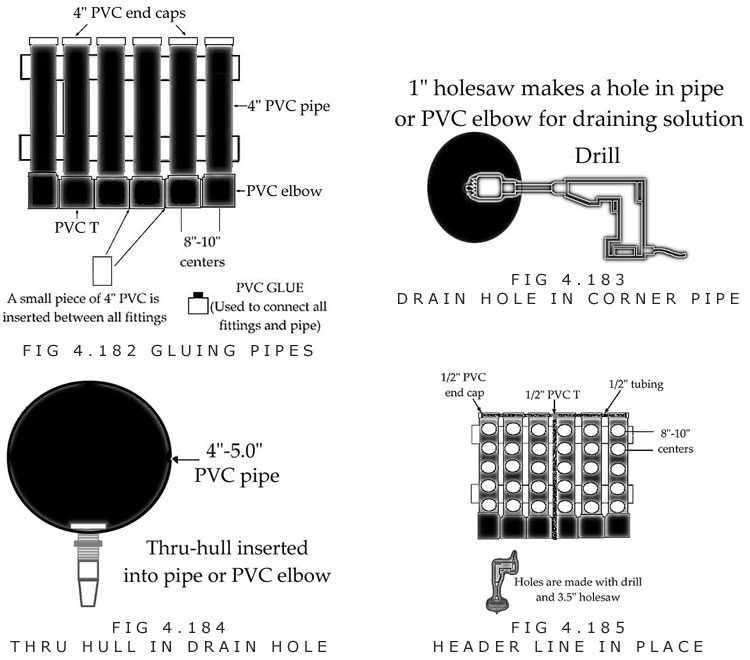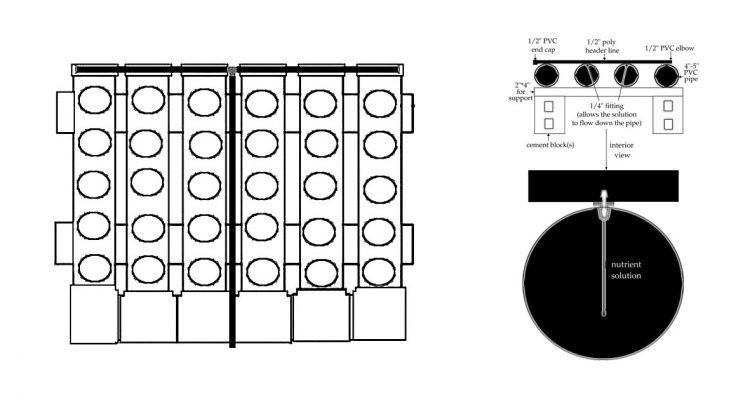NFT Sea of Green Using PVC Pipe
About NFT (Nutrient Film Technique)
With nutrient film technique, plants can be fed with a continuous or intermittent film (using a timer) floating down a trough, PVC pipe, or flood table. The solution travels to the top of a trough through a header line. Then the solution travels down the bottom of the trough where it collects in the reservoir before it is recirculated. Capillary matting can be placed under the trough. Air pumps can be used to aerate the nutrient solution.
Automatic thermostatic heat cords can be placed around a reservoir to keep the solution warm. Chillers cool the reservoir.

NFT System A
Materials
1. 4 to 6-inch PVC pipe.
2. One PVC end cap for each row.
3. One PVC T for each row, less the first and last row.
4. 1/2-inch poly tubing for header line.
5.Three PVC elbows.
6. One 1/2-inch poly end cap.
7. One 1/2-inch poly elbow.
8. 1/4-inch feeder lines.
9. 1/4-inch connecter fittings.
10. Pump.
11. Bypass valve.
12. Reservoir.
Tools
1. Saw.
2. Sandpaper.
3. Drill.
4. 31/2-inch holesaw.
Introduction:
This system is used to grow small plants for the top buds. With this system, the solution goes to the back of the pipes, then it runs down the pipe back into the reservoir. The roots feed from this aerated nutrient solution. A grower can use this system with no medium, or a medium on the bottom of the pipes. Using no medium is the more popular of the two methods because it is much cheaper and easier to set up.
Feeding every 20 minutes for 2 minutes works well and an hourly timer can be used to keep this constant schedule 24 hours a day, 7 days a week. A medium allows a grower less maintenance with only one daily 10-minute feeding session. Lightweight mediums like soilless mix, perlite, vermiculite or coco fibers can be used.
Procedure
A. The 4 to 6-inch pipe will be placed on something that supports it. 4-inch pipe is the cheapest. Pipes can be placed upon cement blocks and 2x4s. (Figure 4.179) Or a quick sawhorse can be made with cheap 2×4 wood (i.e. 2 to 3-foot lengths) with hinges that the 2×4 wood slides into. Another 2×4 (ie. an 8-foot length) is placed between the hinges to complete an instant sawhorse. (Figure 4.180)
B. All piping (i.e. 4-inch PVC) should be cut to the desired length.
C. All lengths of large pipe must have end caps attached to the higher ends (i.e. 1 inch higher) that are located at the far side from the reservoir. (Figure 4.181)

D. All large 4-inch pipes (except the first and last pipe) are connected to their neighboring pipe with T-fittings. The first and last pipe are connected with 4-inch elbows. For example, 4-inch pipe will use 4-inch T-fittings. Small pieces of 4-inch pipe are placed between the T-fittings in order to connect the T-fittings and give the desired spacing (i.e. 10-inch centers). Piping and fittings can be glued with PVC cement (for PVC pipe), but the connections will be permanent. The system should not leak without glue if the pipes and fittings are top quality. A little bit of duct tape can be used for securing connections so that disassembly is easy. (Figure 4.182)
Note: One of the 4-inch PVC elbows will have a 3/4-inch thru-hull inserted into the bottom for draining. (Figures 4.183 and 4.184)
E. Holes (i.e. 31/2 inches) should be cut in the pipe at the desired spacing (i.e. 8 to 12-inch centers). The hole sizes must match the pot sizes to make a custom fit. (Figure 4.185)
F. 1/2-inch hose is laid down from one end of the PVC pipes to the other end. It can be placed in the middle. (Figure 4.185) This hose is connected to a 1/2-inch PVC T at the end. Two pieces of hose are connected to the PVC T until they reach the end. 1/2-inch PVC end caps are attached to the two ends of the hose. (Figure 4.185)

G. A 1/8, 3/16, or 1/4-inch barbed fitting is inserted into the 1/2-inch hose above each pipe. A line punch or 1/16-inch drill bit can be used to make the holes in the tubing for the barbed fittings. Holes must be drilled into each pipe so that the barbed fitting goes inside of each pipe. (Figure 4.186)

H. The 1/2-inch line that runs parallel down the 4-inch PVC pipes is connected to a 1/2-inch PVC elbow. The other side of the 1/2-inch PVC elbow is connected to the pump inside the 20-gallon (or larger) reservoir. (Figure 4.187) A bypass valve can be inserted above the pump to control the flow rate. (Figures 4.187 and 4.188)
I. A 3/4-inch piece of flex hose is connected to the 3/4-inch thru-hull fitting in the 4-inch PVC pipe. This hose runs to the reservoir. It can go directly to the reservoir or it can be connected to a PVC elbow that goes to the reservoir. (Figure 4.187)
K. Plants in 3-inch rockwool cubes or mesh pots can be placed in the bottom of the pipe.



